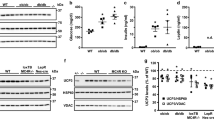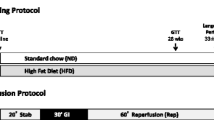Abstract
Recent evidence has suggested that activation of AMP-activated protein kinase (AMPK) induced by short-term caloric restriction (CR) protects against myocardial ischemia-reperfusion (I/R) injury. Because AMPK plays a central role in regulating energy metabolism, we investigated whether alterations in cardiac energy metabolism contribute to the cardioprotective effects induced by CR. Hearts from control or short-term CR mice were subjected to ex vivo I/R and metabolism, as well as post-ischemic functional recovery was measured. Even in the presence of elevated levels of fatty acids, CR significantly improved recovery of cardiac function following ischemia. While rates of fatty acid oxidation or glycolysis from exogenous glucose were similar between groups, improved functional recovery post-ischemia in CR hearts was associated with high rates of glucose oxidation during reperfusion compared to controls. Consistent with CR improving energy supply, hearts from CR mice had increased ATP levels, as well as lower AMPK activity at the end of reperfusion compared to controls. Furthermore, in agreement with the emerging concept that CR is a non-conventional form of pre-conditioning, we observed a significant increase in phosphorylation of Akt and Erk1/2 at the end of reperfusion. These data also suggest that activation of the reperfusion salvage kinase (RISK) pathway also contributes to the beneficial effects of CR in reducing post-ischemia contractile dysfunction. These findings also suggest that short-term CR improves post-ischemic recovery by promoting glucose oxidation, and activating the RISK pathway. As such, pre-operative CR may be a clinically relevant strategy for increasing ischemic tolerance of the heart.





Similar content being viewed by others
References
Bolli R, Marban E (1999) Molecular and cellular mechanisms of myocardial stunning. Physiol Rev 79:609–634
Moens AL, Claeys MJ, Timmermans JP, Vrints CJ (2005) Myocardial ischemia/reperfusion injury, a clinical view on a complex pathophysiological process. Int J Cardiol 100:179–190
Yellon DM, Downey JM (2003) Preconditioning the myocardium: from cellular physiology to clinical cardiology. Physiol Rev 83:1113–1151
Peart JN, Headrick JP (2008) Sustained cardioprotection: exploring unconventional modalities. Vascul Pharmacol 49:63–70
Shinmura K, Tamaki K, Bolli R (2005) Short-term caloric restriction improves ischemic tolerance independent of opening of ATP-sensitive K+ channels in both young and aged hearts. J Mol Cell Cardiol 39:285–296
Shinmura K, Tamaki K, Saito K, Nakano Y, Tobe T, Bolli R (2007) Cardioprotective effects of short-term caloric restriction are mediated by adiponectin via activation of AMP-activated protein kinase. Circulation 116:2809–2817
Bertomeu-Gonzalez V, Bouzas-Mosquera A, Kaski JC (2006) Role of trimetazidine in management of ischemic cardiomyopathy. Am J Cardiol 98:19J–24J
Liu Q, Docherty JC, Rendell JC, Clanachan AS, Lopaschuk GD (2002) High levels of fatty acids delay the recovery of intracellular pH and cardiac efficiency in post-ischemic hearts by inhibiting glucose oxidation. J Am Coll Cardiol 39:718–725
Lopaschuk GD, Collins-Nakai R, Olley PM, Montague TJ, McNeil G, Gayle M, Penkoske P, Finegan BA (1994) Plasma fatty acid levels in infants and adults after myocardial ischemia. Am Heart J 128:61–67
Dyck JR, Lopaschuk GD (2006) AMPK alterations in cardiac physiology and pathology: enemy or ally? J Physiol 574:95–112
Liu B, Clanachan AS, Schulz R, Lopaschuk GD (1996) Cardiac efficiency is improved after ischemia by altering both the source and fate of protons. Circ Res 79:940–948
Liu B, el Alaoui-Talibi Z, Clanachan AS, Schulz R, Lopaschuk GD (1996) Uncoupling of contractile function from mitochondrial TCA cycle activity and MVO2 during reperfusion of ischemic hearts. Am J Physiol 270:H72–H80
Kantor PF, Dyck JR, Lopaschuk GD (1999) Fatty acid oxidation in the reperfused ischemic heart. Am J Med Sci 318:3–14
Stanley WC, Lopaschuk GD, Hall JL, McCormack JG (1997) Regulation of myocardial carbohydrate metabolism under normal and ischaemic conditions. Potential for pharmacological interventions. Cardiovasc Res 33:243–257
Hausenloy DJ, Tsang A, Mocanu MM, Yellon DM (2005) Ischemic preconditioning protects by activating prosurvival kinases at reperfusion. Am J Physiol Heart Circ Physiol 288:H971–H976
Kuang M, Febbraio M, Wagg C, Lopaschuk GD, Dyck JR (2004) Fatty acid translocase/CD36 deficiency does not energetically or functionally compromise hearts before or after ischemia. Circulation 109:1550–1557
Finegan BA, Gandhi M, Cohen MR, Legatt D, Clanachan AS (2003) Isoflurane alters energy substrate metabolism to preserve mechanical function in isolated rat hearts following prolonged no-flow hypothermic storage. Anesthesiology 98:379–386
An D, Pulinilkunnil T, Qi D, Ghosh S, Abrahani A, Rodrigues B (2005) The metabolic “switch” AMPK regulates cardiac heparin-releasable lipoprotein lipase. Am J Physiol Endocrinol Metab 288:E246–E253
Cross HR, Opie LH, Radda GK, Clarke K (1996) Is a high glycogen content beneficial or detrimental to the ischemic rat heart? A controversy resolved. Circ Res 78:482–491
Kramer HF, Witczak CA, Taylor EB, Fujii N, Hirshman MF, Goodyear LJ (2006) AS160 regulates insulin- and contraction-stimulated glucose uptake in mouse skeletal muscle. J Biol Chem 281:31478–31485
McCurdy CE, Davidson RT, Cartee GD (2003) Brief calorie restriction increases Akt2 phosphorylation in insulin-stimulated rat skeletal muscle. Am J Physiol Endocrinol Metab 285:E693–E700
Giani JF, Bonkowski MS, Munoz MC, Masternak MM, Turyn D, Bartke A, Dominici FP (2008) Insulin signaling cascade in the hearts of long-lived growth hormone receptor knockout mice: effects of calorie restriction. J Gerontol A Biol Sci Med Sci 63:788–797
Nishino Y, Webb IG, Davidson SM, Ahmed AI, Clark JE, Jacquet S, Shah AM, Miura T, Yellon DM, Avkiran M, Marber MS (2008) Glycogen synthase kinase-3 inactivation is not required for ischemic preconditioning or postconditioning in the mouse. Circ Res 103:307–314
Sinclair DA (2005) Toward a unified theory of caloric restriction and longevity regulation. Mech Ageing Dev 126:987–1002
Kondo M, Shibata R, Miura R, Shimano M, Kondo K, Li P, Ohashi T, Kihara S, Maeda N, Walsh K, Ouchi N, Murohara T (2009) Caloric restriction stimulates revascularization in response to ischemia via adiponectin-mediated activation of endothelial nitric-oxide synthase. J Biol Chem 284:1718–1724
Shibata R, Sato K, Pimentel DR, Takemura Y, Kihara S, Ohashi K, Funahashi T, Ouchi N, Walsh K (2005) Adiponectin protects against myocardial ischemia-reperfusion injury through AMPK- and COX-2-dependent mechanisms. Nat Med 11:1096–1103
Shibata R, Ouchi N, Ito M, Kihara S, Shiojima I, Pimentel DR, Kumada M, Sato K, Schiekofer S, Ohashi K, Funahashi T, Colucci WS, Walsh K (2004) Adiponectin-mediated modulation of hypertrophic signals in the heart. Nat Med 10:1384–1389
Hardie DG (2007) AMP-activated protein kinase as a drug target. Annu Rev Pharmacol Toxicol 47:185–210
Lopaschuk GD, Barr R, Thomas PD, Dyck JR (2003) Beneficial effects of trimetazidine in ex vivo working ischemic hearts are due to a stimulation of glucose oxidation secondary to inhibition of long-chain 3-ketoacyl coenzyme a thiolase. Circ Res 93:e33–e37
Dean DJ, Brozinick JT Jr, Cushman SW, Cartee GD (1998) Calorie restriction increases cell surface GLUT-4 in insulin-stimulated skeletal muscle. Am J Physiol 275:E957–E964
Doenst T, Richwine RT, Bray MS, Goodwin GW, Frazier OH, Taegtmeyer H (1999) Insulin improves functional and metabolic recovery of reperfused working rat heart. Ann Thorac Surg 67:1682–1688
Dean DJ, Cartee GD (2000) Calorie restriction increases insulin-stimulated tyrosine phosphorylation of insulin receptor and insulin receptor substrate-1 in rat skeletal muscle. Acta Physiol Scand 169:133–139
McCurdy CE, Cartee GD (2005) Akt2 is essential for the full effect of calorie restriction on insulin-stimulated glucose uptake in skeletal muscle. Diabetes 54:1349–1356
Hausenloy DJ, Yellon DM (2004) New directions for protecting the heart against ischaemia-reperfusion injury: targeting the reperfusion injury salvage kinase (RISK) pathway. Cardiovasc Res 61:448–460
Crackower MA, Oudit GY, Kozieradzki I, Sarao R, Sun H, Sasaki T, Hirsch E, Suzuki A, Shioi T, Irie-Sasaki J, Sah R, Cheng HY, Rybin VO, Lembo G, Fratta L, Oliveira-dos-Santos AJ, Benovic JL, Kahn CR, Izumo S, Steinberg SF, Wymann MP, Backx PH, Penninger JM (2002) Regulation of myocardial contractility and cell size by distinct PI3K-PTEN signaling pathways. Cell 110:737–749
Sasaki T, Irie-Sasaki J, Jones RG, Oliveira-dos-Santos AJ, Stanford WL, Bolon B, Wakeham A, Itie A, Bouchard D, Kozieradzki I, Joza N, Mak TW, Ohashi PS, Suzuki A, Penninger JM (2000) Function of PI3Kgamma in thymocyte development, T cell activation, and neutrophil migration. Science 287:1040–1046
Acknowledgments
The authors thank the staff of the HPLC Core of the Cardiovascular Research Centre (CVRC) at the University of Alberta and acknowledge the expert technical assistance of Sandra Kelly and Suzanne Kovacic.
Disclosures
No conflicts of interest declared by the authors.
Grants
This research was supported by grants from the Canadian Institutes of Health Research (CIHR) to JRBD. MMS is supported by an Alberta Heritage Foundation for Medical Research (AHFMR) Studentship award. JRBD is AHFMR Senior Scholar and a Canada Research Chair in Molecular Biology of Heart Disease and Metabolism.
Author information
Authors and Affiliations
Corresponding author
Rights and permissions
About this article
Cite this article
Sung, M.M.Y., Soltys, CL.M., Masson, G. et al. Improved cardiac metabolism and activation of the RISK pathway contributes to improved post-ischemic recovery in calorie restricted mice. J Mol Med 89, 291–302 (2011). https://doi.org/10.1007/s00109-010-0703-5
Received:
Revised:
Accepted:
Published:
Issue Date:
DOI: https://doi.org/10.1007/s00109-010-0703-5




